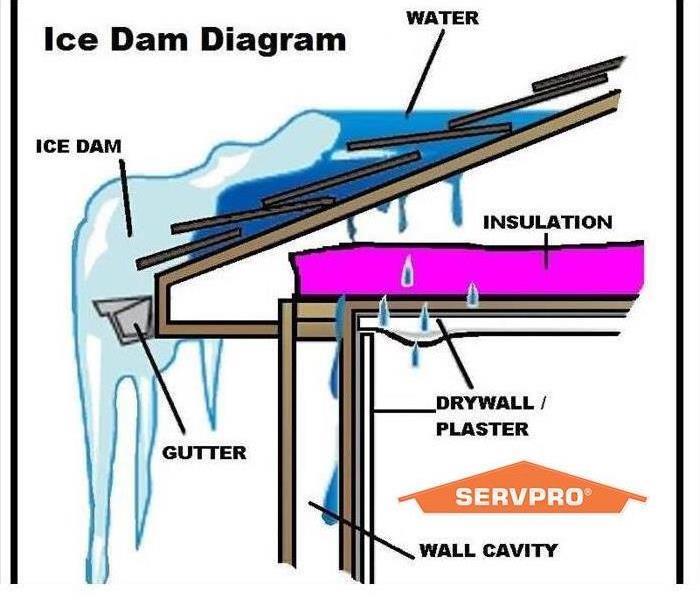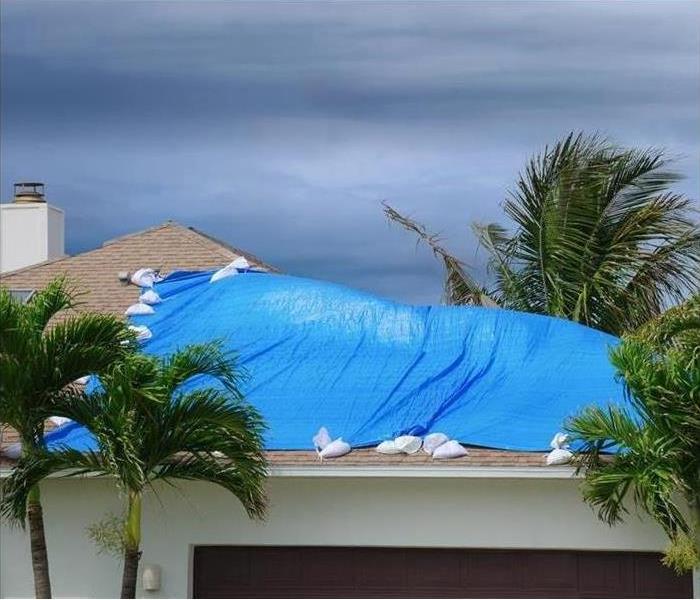Recent Storm Damage Posts
Spring Storms Can Bring Flooding
3/1/2023 (Permalink)
Unfortunately, we have seen our fair share of flooding in recent years here in Blount County. According to the National Weather Service Approximately, five percent of all Presidential disaster declarations are associated with flooding. Just because you haven’t experienced a flood doesn’t mean you won’t sometime in the future. About 20% of all claims paid by the National Flood Insurance Program (NFIP) were for policies in low-risk communities. On average, floods cost $3.5 billion in annual losses in the United States.
The National Weather Service lists the following most common flood hazards:
- Flash Flooding
- River Flooding
- Dam Breaks/Levee Failure
- Dry Wash (Heavy Rainfalls in Dry Areas)
- Snowmelt
- Ice Damming
- Burn Scars/Debris Flows
- Storm Surge and Coastal Flooding from Tropical Storms
When catastrophic water damage happens to you, SERVPRO® of Blount County professionals can help at 865-982-2332.
We can respond to any size disaster to begin cleanup and restoration to get you back in your home or business as soon as possible.
Winter Weather Hazards
9/27/2022 (Permalink)
Winter Storm Damage
Winter weather can bring about more issues than just slippery roads and a sidewalk to shovel. If you live where temperatures sink below freezing level, you are at risk for frozen pipes and ice dams, which can create a major disaster at your home or property.
FROZEN PIPES
Frozen pipes are often those pipes exposed to the cold weather, such as those on outer walls or outside your house, or in cold areas such as basements, attics, garages or even kitchen cabinets.
A frozen pipe can burst at the point where the ice blockage inside the pipe is located, but typically the rupture is caused by the backflow pressure between the water source and the obstruction. A burst pipe can cause considerable damage to your property if not addressed quickly.
To prevent pipes from freezing, here are a few steps you can take, according to The American Red Cross.
-Be sure to thoroughly drain water from swimming pool and sprinkler lines, as well as outside hoses.
-Open kitchen cabinets to let warm air circulate near the plumbing when temperatures are below freezing for an extended time.
-When the weather is frigid, let water drip from faucets that may come from exposed pipes.
-Keep your heat set to the same temperature both day and night.
ICE DAMS
Ice dams can be a little-known, but significant problem during the snowy season. They form when heated air melts roof snow downward into water dammed behind still-frozen ice. When water cannot safely flow or run into the gutter system, it will cause backflow under the roof ’s shingles and into the structure’s interior areas.
Icicles can be an initial sign of an ice dam, according to Travelers.com. To spot ice dams inside; check for water stains or moisture in your attic or along with the ceiling of the exterior walls of your house. Water stains or moisture may be an indication that an ice dam has formed and water has penetrated the roof membrane.”
Removing an ice dam as soon as it is found is vital to help prevent damage to your property and can be done using heated cables, a roof shovel or calcium chloride ice melter.
If winter weather causes water damage to your property, SERVPRO® of Blount County is only a call away, 24/7, ready to restore to preloss condition. (865) 982-2332
Severe Weather Safety In Blount County TN
4/7/2022 (Permalink)
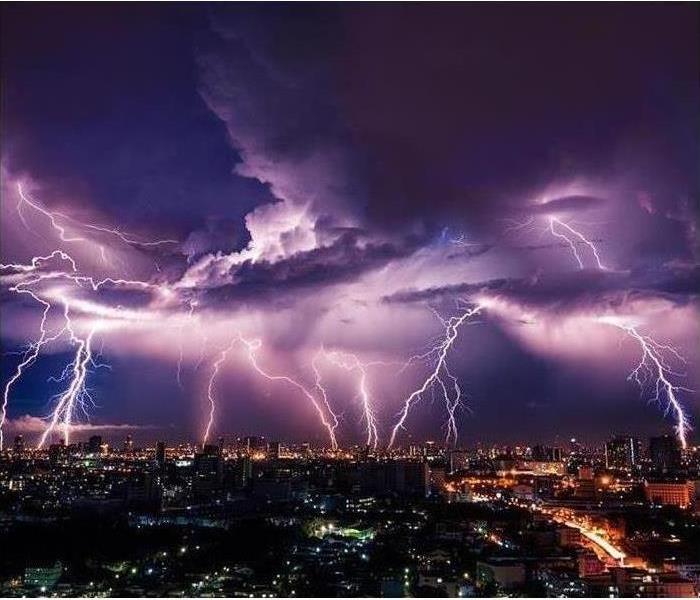 Lighting strikes as a severe storm moves closer to downtown Maryville
Lighting strikes as a severe storm moves closer to downtown Maryville
Severe weather can happen any time, anywhere. Each year, Americans cope with an average of the following intense storms.
According to the National Storm Prediction Center NOAA SPC watch year their are.
-10,000 severe thunderstorms
-5,000 floods or flash floods
-1,300 tornadoes
-2 landfalling deadly hurricanes
Approximately 98 percent of all presidentially declared disasters are weather-related, leading to around 650 deaths per year and nearly $15 billion in damage. Knowing your risk severe weather, taking action, and being an example are just a few steps you can take to be better prepared to save your life and assist in saving the lives of others.
Know Your Risk. The first step to becoming weather-ready is to understand the type of hazardous weather that can affect where you live and work, and how the weather could impact you, your business, and your family. Check the weather forecast regularly, obtain an NOAA Weather Radio, and learn about Wireless Emergency Alerts. Severe weather comes in many forms and your shelter plan should include all types of local hazards.
Be an Example. Once you have taken action to prepare for severe weather, share your story with co-workers and family and friends on Facebook and Twitter. Your preparedness story will inspire others to do the same.
Call SERVPRO of Blount County: We Are Faster To Any Size Disaster
3/7/2022 (Permalink)
Storms Bring Flooding Problems
Unfortunately, we have seen our fair share of flooding in recent years here in Blount County. According to the National Weather Service Approximately, five percent of all Presidential disaster declarations are associated with flooding. Just because you haven’t experienced a flood doesn’t mean you won’t sometime in the future. About 20% of all claims paid by the National Flood Insurance Program (NFIP) were for policies in low-risk communities. On average, floods cost $3.5 billion in annual losses in the United States.
The National Weather Service lists the following most common flood hazards:
- Flash Flooding
- River Flooding
- Dam Breaks/Levee Failure
- Dry Wash (Heavy Rainfalls in Dry Areas)
- Snowmelt
- Ice Damming
- Burn Scars/Debris Flows
- Storm Surge and Coastal Flooding from Tropical Storms
When catastrophic water damage happens to you, SERVPRO® Professionals can help at 865-982-2332.
We can help you prepare ahead of time with an Emergency Ready Profile® (ERP), or respond to any size disaster to begin cleanup and restoration to get you back in your home as soon as possible.
Be Storm Smart
12/17/2021 (Permalink)
Severe weather can happen anytime, anywhere. Each year, Americans cope with an average of these following intense storms.
10,000 severe thunderstorms
5,000 floods or flash floods
1,000 tornadoes
2 land falling deadly hurricanes
Approximately 98 percent of all presidentially declared disasters are weather-related, leading to around 500 deaths per year and nearly $15 billion in damage. Knowing your risk of severe weather, taking action and being an example are just a few steps you can take to be better prepared to save your life and assist in saving the lives others.
Know Your Risk. The first step to becoming weather-ready is to understand the type of hazardous weather that can affect where you live and work, and how the weather could impact you, your business and your family. Check the weather forecast regularly, obtain a NOAA Weather Radio, and learn about Wireless Emergency Alerts. Severe weather comes in many forms and your shelter plan should include all types of local hazards.
Take Action. Take the next step in severe weather preparedness by creating a communications plan for your home and business. Put together or purchase an emergency kit. Keep important papers and valuables in a safe place.
Be an Example. Once you have taken action to prepare for severe weather, share your story with co-works and family and friends on Facebook or Twitter. Your preparedness story will inspire others to do the same.
Water (one gallon per person per day)
Food (non-perishable 3-day supply)
Manual can opener
Battery operated radio, preferably a NOAA Weather Radio
Flashlight and extra batteries
First aid kit
Whistle to signal for help
Clothing
Dust masks or bandanas
Plastic sheeting, garbage bags, and duct tape
Wrench or pliers to turn off utilities
Hygiene items
Important documents; copies of insurance policies, identification, and bank account information
Cash
Fire extinguisher
Matches in a waterproof contain
If your home or business experiences storm related damages, call your local professionals at SERVPRO of Blount County. From board ups to dry-outs we are your local Maryville/Alcoa choice for emergency services.
Leave the Hassle of Board-ups to the Professionals
12/17/2021 (Permalink)
Whether after a fire, storm, or other structural disasters, boarding up damaged property is a burden that no one should ever have to go through—especially if it is your property that has been damaged.
Boarding up damaged property incorrectly could cause secondary damages such as moisture or animal intrusion, making the situation and extensiveness of damages even
worse. The process of boarding up after an unexpected storm, or fire damage can also be as dangerous as the damage itself. Make sure to call a professional to mitigate further damages and create a safe structure.
Your SERVPRO® Franchise Professionals can board up the damaged property and mitigate and remediate the original damage, providing you with peace of mind while helping make it “Like it never even happened.”
Give us a call at (865)-982-2332 if your Blount County property needs emergency board-up services!
Keeping Wind Damage In Check
11/29/2021 (Permalink)
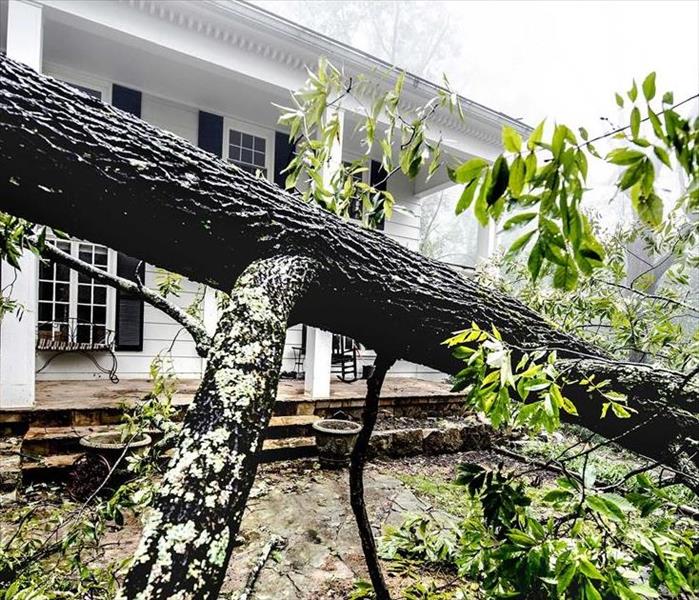 After heavy storms in Blount County Tennessee, which toppled several trees and lifted roofs, causing sever damage.
After heavy storms in Blount County Tennessee, which toppled several trees and lifted roofs, causing sever damage.
Keeping Wind Damage In Check
When the weather turns ugly and the winds get strong in Maryville TN, homes aren’t the only structures at risk. Business owners know they have to take steps to protect their buildings. You can’t afford to ignore the risks of high winds. Here are four ways to protect your commercial building:
Have Tarps and Plywood On Hand
Water damage can destroy the inside of your commercial building. If you have a damaged roof or missing shingles after a windstorm, tarps and plywood can help control water intrusion. Use these until you have time to schedule a total roof repair.
Anchor Projectiles
Do an exterior walk around at your business before severe weather hits. Pay special attention to possible projectiles. If you see anything that may fly freely through the air in a storm, you should anchor it. Move those hazards inside if possible and if not, using a tie-down is often an effective solution.
Clear Trees and Other Debris
Damage to roofing systems can cause a roof leak. If you can keep trees and other debris from crashing through your business’s roof, you can help prevent that from happening. Consider trimming overhanging branches and removing landscape waste a few times a year.
Reinforce Garage-Style Doors
Garage-style doors often do not fare well during inclement weather. These doors are usually large and flimsy. If your business has one you should think about reinforcing it. Lumber or metal rods can increase the chances that your company’s garage doors will ride out the storm with little or no damage. Moreover, if you are expecting heavy rains, you should ensure all doors are securely closed before evacuating ahead of a storm.
In case of any storm damage or water damage resulting from roof damage, call SERVPRO of Blount County at 865-982-2332 to help you get your company back up and running as soon as possible.
Winter Weather Hazards
9/13/2021 (Permalink)
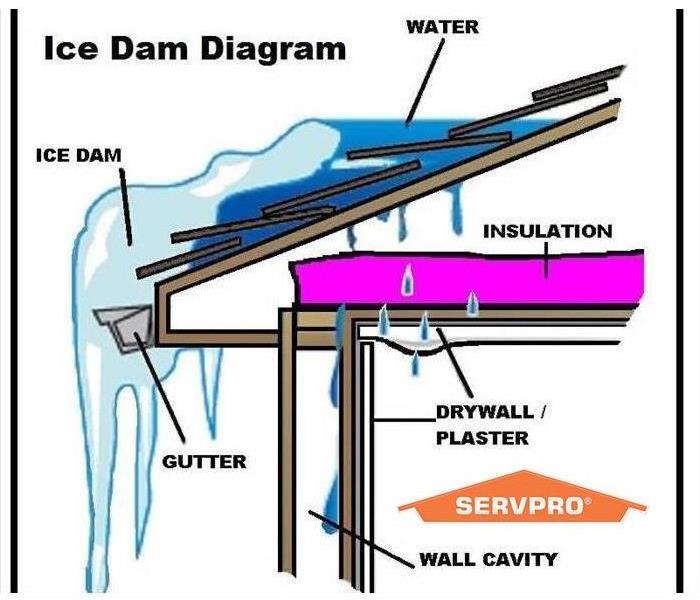 Image description of how an ice damn can cause long term damages to your structure
Image description of how an ice damn can cause long term damages to your structure
Winter Storm Damage
Winter weather can bring about more issues than just slippery roads and a sidewalk to shovel. If you live where temperatures sink below freezing level, you are at risk for frozen pipes and ice dams, which can create a major disaster at your home or property.
FROZEN PIPES
Frozen pipes are often those exposed to the cold weather, such as those outside your house, or in cold areas such as basements, attics, garages or kitchen cabinets.
A frozen pipe can burst at the point where the ice blockage inside the pipe is located, but typically the rupture is caused by the backflow pressure between the water source and the obstruction. A burst pipe can cause considerable damage to your property if not addressed quickly.
To prevent pipes from freezing, here are a few steps you can take, according to The American Red Cross.
-Be sure to thoroughly drain water from swimming pool and sprinkler lines, as well as outside hoses.
-Open kitchen cabinets to let warm air circulate near the plumbing.
-When the weather is frigid, let water drip from faucets that may come from exposed pipes.
-Keep your heat set to the same temperature both day and night.
ICE DAMS
Ice dams can be a little-known, but a significant problem during the snowy season. They form when heated air melts roof snow downward into water dammed behind still-frozen ice. When water cannot safely flow or run into the gutter system, it will cause backflow under the roof ’s shingles and into the structure’s interior areas.
Icicles can be an initial sign of an ice dam, according to Travelers.com. To spot ice dams inside; check for water stains or moisture in your attic or along with the ceiling of the exterior walls of your house. Water stains or moisture may be an indication that an ice dam has formed and water has penetrated the roof membrane.”
Removing an ice dam as soon as it is found is vital to help prevent damage to your property and can be done using heated cables, a roof shovel or calcium chloride ice melter.
If winter weather causes water damage to your property, SERVPRO® of Blount County is only a call away, 24/7, ready to restore to preloss condition. (865) 982-2332
Severe Weather Safety
2/12/2021 (Permalink)
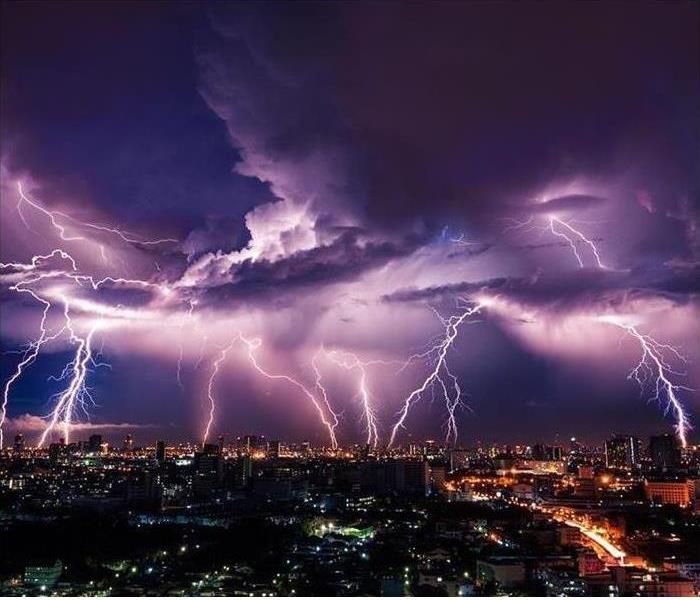 Lighting strikes as a severe storm moves closer to downtown Maryville/Alcoa
Lighting strikes as a severe storm moves closer to downtown Maryville/Alcoa
Severe weather can happen any time, anywhere. Each year, Americans cope with an average of the following intense storms.
According to the National Storm Prediction Center NOAA SPC watch year their are.
- 10,000 severe thunderstorms
-5,000 floods or flash floods
-1,300 tornadoes
-2 landfalling deadly hurricanes
Approximately 98 percent of all presidentially declared disasters are weather-related, leading to around 650 deaths per year and nearly $15 billion in damage. Knowing your risk severe weather, taking action, and being an example are just a few steps you can take to be better prepared to save your life and assist in saving the lives of others.
Know Your Risk. The first step to becoming weather-ready is to understand the type of hazardous weather that can affect where you live and work, and how the weather could impact you, your business, and your family. Check the weather forecast regularly, obtain an NOAA Weather Radio, and learn about Wireless Emergency Alerts. Severe weather comes in many forms and your shelter plan should include all types of local hazards.
Be an Example. Once you have taken action to prepare for severe weather, share your story with co-workers and family and friends on Facebook and Twitter Your preparedness story will inspire others to do the same.
Be Storm Smart
12/15/2020 (Permalink)
Severe weather can happen anytime, anywhere. Each year, Americans cope with an average of these following intense storms.
10,000 severe thunderstorms
5,000 floods or flash floods
1,000 tornadoes
2 land falling deadly hurricanes
Approximately 98 percent of all presidentially declared disasters are weather-related, leading to around 500 deaths per year and nearly $15 billion in damage. Knowing your risk of severe weather, taking action and being an example are just a few steps you can take to be better prepared to save your life and assist in saving the lives others.
Know Your Risk. The first step to becoming weather-ready is to understand the type of hazardous weather that can affect where you live and work, and how the weather could impact you, your business and your family. Check the weather forecast regularly, obtain a NOAA Weather Radio, and learn about Wireless Emergency Alerts. Severe weather comes in many forms and your shelter plan should include all types of local hazards.
Take Action. Take the next step in severe weather preparedness by creating a communications plan for your home and business. Put together or purchase an emergency kit. Keep important papers and valuables in a safe place.
Be an Example. Once you have taken action to prepare for severe weather, share your story with co-works and family and friends on Facebook or Twitter. Your preparedness story will inspire others to do the same.
Water (one gallon per person per day)
Food (non-perishable 3-day supply)
Manual can opener
Battery operated radio, preferably a NOAA Weather Radio
Flashlight and extra batteries
First aid kit
Whistle to signal for help
Clothing
Dust masks or bandanas
Plastic sheeting, garbage bags, and duct tape
Wrench or pliers to turn off utilities
Hygiene items
Important documents; copies of insurance policies, identification, and bank account information
Cash
Fire extinguisher
Matches in a waterproof contain
If your home or business experiences storm related damages, call your local professionals at SERVPRO of Blount County. From board ups to dry-outs we are your local Maryville/Alcoa choice for emergency services.
Leave the Hassle of Board-ups to the Professionals
12/14/2020 (Permalink)
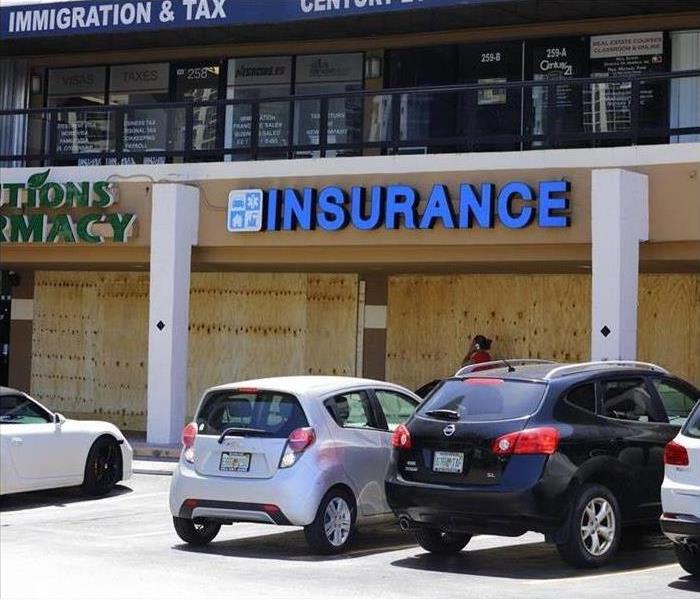 Boarded up windows prior to a hurricane moving into the area
Boarded up windows prior to a hurricane moving into the area
Whether after a fire, storm, or other structural disasters, boarding up damaged property is a burden that no one should ever have to go through—especially if it is your property that has been damaged.
Boarding up damaged property incorrectly could cause secondary damages such as moisture or animal intrusion, making the situation and extensiveness of damages even
worse. The process of boarding up after an unexpected storm, or fire damage can also be as dangerous as the damage itself. Make sure to call a professional to mitigate further damages and create a safe structure.
Your SERVPRO® Franchise Professionals can board up the damaged property and mitigate and remediate the original damage, providing you with peace of mind while helping make it “Like it never even happened.”
Give us a call at (865)-982-2332 if your Blount County property needs emergency board-up services!
Keeping Wind Damage In Check
11/27/2020 (Permalink)
Keeping Wind Damage In Check
When the weather turns ugly and the winds get strong in Maryville TN, homes aren’t the only structures at risk. Business owners know they have to take steps to protect their buildings. You can’t afford to ignore the risks of high winds. Here are four ways to protect your commercial building:
Have Tarps and Plywood On Hand
Water damage can destroy the inside of your commercial building. If you have a damaged roof or missing shingles after a windstorm, tarps and plywood can help control water intrusion. Use these until you have time to schedule a total roof repair.
Anchor Projectiles
Do an exterior walk around at your business before severe weather hits. Pay special attention to possible projectiles. If you see anything that may fly freely through the air in a storm, you should anchor it. Move those hazards inside if possible and if not, using a tie-down is often an effective solution.
Clear Trees and Other Debris
Damage to roofing systems can cause a roof leak. If you can keep trees and other debris from crashing through your business’s roof, you can help prevent that from happening. Consider trimming overhanging branches and removing landscape waste a few times a year.
Reinforce Garage-Style Doors
Garage-style doors often do not fare well during inclement weather. These doors are usually large and flimsy. If your business has one you should think about reinforcing it. Lumber or metal rods can increase the chances that your company’s garage doors will ride out the storm with little or no damage. Moreover, if you are expecting heavy rains, you should ensure all doors are securely closed before evacuating ahead of a storm.
In case of any storm damage or water damage resulting from roof damage, call SERVPRO of Blount County at 865-982-2332 to help you get your company back up and running as soon as possible.
Winter Weather Hazards
9/1/2020 (Permalink)
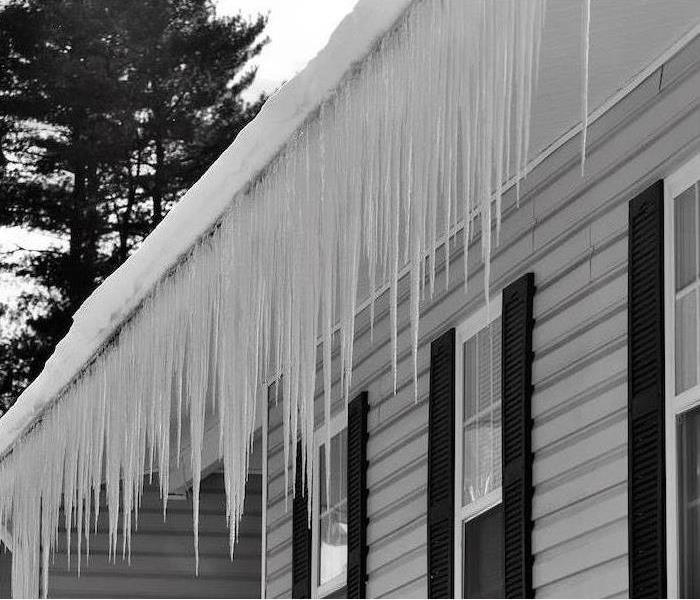 Ice and snow on your roof can lead to heavy damages. Be on the lookout for this!
Ice and snow on your roof can lead to heavy damages. Be on the lookout for this!
Winter weather can bring about more issues than just slippery roads and a sidewalk to shovel. If you live where temperatures sink below freezing level, you are at risk for frozen pipes and ice dams, which can create a major disaster at your home or property.
FROZEN PIPES
Frozen pipes are often those exposed to the cold weather, such as those outside your house, or in cold areas such as basements, attics, garages or kitchen cabinets.
A frozen pipe can burst at the point where the ice blockage inside the pipe is located, but typically the rupture is caused by the backflow pressure between the water source and the obstruction. A burst pipe can cause considerable damage to your property if not addressed quickly.
To prevent pipes from freezing, here are a few steps you can take, according to The American Red Cross.
-Be sure to thoroughly drain water from swimming pool and sprinkler lines, as well as outside hoses.
-Open kitchen cabinets to let warm air circulate near the plumbing.
-When the weather is frigid, let water drip from faucets that may come from exposed pipes.
-Keep your heat set to the same temperature both day and night.
ICE DAMS
Ice dams can be a little-known, but a significant problem during the snowy season. They form when heated air melts roof snow downward into water dammed behind still-frozen ice. When water cannot safely flow or run into the gutter system, it will cause backflow under the roof ’s shingles and into the structure’s interior areas.
Icicles can be an initial sign of an ice dam, according to Travelers.com. To spot ice dams inside; check for water stains or moisture in your attic or along with the ceiling of the exterior walls of your house. Water stains or moisture may be an indication that an ice dam has formed and water has penetrated the roof membrane.”
Removing an ice dam as soon as it is found is vital to help prevent damage to your property and can be done using heated cables, a roof shovel or calcium chloride ice melter.
If winter weather causes water damage to your property, SERVPRO® of Blount County is only a call away, 24/7, ready to restore to preloss condition.
Call SERVPRO of Blount County: We Are Faster To Any Size Disaster
3/9/2020 (Permalink)
Storms Bring Flooding Problems
Unfortunately, we have seen our fair share of flooding in recent years here in Blount County. According to the National Weather Service Approximately, five percent of all Presidential disaster declarations are associated with flooding. Just because you haven’t experienced a flood doesn’t mean you won’t sometime in the future. About 20% of all claims paid by the National Flood Insurance Program (NFIP) were for policies in low-risk communities. On average, floods cost $3.5 billion in annual losses in the United States.
The National Weather Service lists the following most common flood hazards:
- Flash Flooding
- River Flooding
- Dam Breaks/Levee Failure
- Dry Wash (Heavy Rainfalls in Dry Areas)
- Snowmelt
- Ice Damming
- Burn Scars/Debris Flows
- Storm Surge and Coastal Flooding from Tropical Storms
When catastrophic water damage happens to you, SERVPRO® Professionals can help at 865-982-2332. We can help you prepare ahead of time with an Emergency Ready Profile® (ERP), or respond to any size disaster to begin cleanup and restoration to get you back in your home as soon as possible.
SERVPRO® of Blount County Professionals are ready to help make it “Like it never even happened.”
Storm Safety 101
1/14/2020 (Permalink)
Storm Safety 101
Severe weather and storms can happen anytime of the year. Did you know that approximately 98% of all presidentially declared disasters are weather-related? Severe weather leads to around 500 deaths per year and almost $15 billion in damage. Each year in the United States we have over:
10,000 severe thunderstorms
5,000 floods or flash floods
1,000 tornadoes
2 deadly hurricanes that make landfall
Knowing your risk of severe weather and taking a few simple steps of action can help save your life and possibly the lives of others.
Know Your Risk: The first step to becoming weather-ready is to understand the type of severe weather that typically affects the area where you live and work and how this could impact you, your business and your family. Check your local forecast regularly, obtain a NOAA Weather Radio and learn about Wireless Emergency Alerts. Severe weather comes in many forms and your shelter plan should include all types of local hazards.
Take Action: Take the next step by creating a communications plan for your home and business. Put together an Emergency Kit. Keep important papers, valuables and medications in a safe place.
Tell Others: Once you have prepared your home and business, share your story with co-workers, neighbors, family and friends on Facebook, Twitter and Instagram. Your preparedness story will inspire others to do the same.
Keeping Wind Damage In Check
11/25/2019 (Permalink)
Keeping Wind Damage In Check
When the weather turns ugly and the winds get strong in Maryville TN, homes aren’t the only structures at risk. Business owners know they have to take steps to protect their buildings. You can’t afford to ignore the risks of high winds. Here are four ways to protect your commercial building:
Have Tarps and Plywood On Hand
Water damage can destroy the inside of your commercial building. If you have a damaged roof or missing shingles after a windstorm, tarps and plywood can help control water intrusion. Use these until you have time to schedule a total roof repair.
Anchor Projectiles
Do an exterior walk around at your business before severe weather hits. Pay special attention to possible projectiles. If you see anything that may fly freely through the air in a storm, you should anchor it. Move those hazards inside if possible and if not, using a tie-down is often an effective solution.
Clear Trees and Other Debris
Damage to roofing systems can cause a roof leak. If you can keep trees and other debris from crashing through your business’s roof, you can help prevent that from happening. Consider trimming overhanging branches and removing landscape waste a few times a year.
Reinforce Garage-Style Doors
Garage-style doors often do not fare well during inclement weather. These doors are usually large and flimsy. If your business has one you should think about reinforcing it. Lumber or metal rods can increase the chances that your company’s garage doors will ride out the storm with little or no damage. Moreover, if you are expecting heavy rains, you should ensure all doors are securely closed before evacuating ahead of a storm.
In case of any storm damage or water damage resulting from roof damage, call SERVPRO of Blount County at 865-982-2332 to help you get your company back up and running as soon as possible.
Winter Weather
8/14/2019 (Permalink)
Winter weather can bring about more issues than just slippery roads and a sidewalk to shovel. If you live where temperatures sink below freezing level, you are at risk for frozen pipes and ice dams, which can create a major disaster at your home or property.
FROZEN PIPES
Frozen pipes are often those exposed to the cold weather, such as those outside your house, or in cold areas such as basements, attics, garages or kitchen cabinets.
A frozen pipe can burst at the point where the ice blockage inside the pipe is located, but typically the rupture is caused by the backflow pressure between the water source and the obstruction. A burst pipe can cause considerable damage to your property if not addressed quickly.
To prevent pipes from freezing, here are a few steps you can take, according to The American Red Cross.
-Be sure to thoroughly drain water from swimming pool and sprinkler lines, as well as outside hoses.
-Open kitchen cabinets to let warm air circulate near the plumbing.
-When the weather is frigid, let water drip from faucets that may come from exposed pipes.
-Keep your heat set to the same temperature both day and night.
ICE DAMS
Ice dams can be a little-known, but a significant problem during the snowy season. They form when heated air melts roof snow downward into water dammed behind still-frozen ice. When water cannot safely flow or run into the gutter system, it will cause backflow under the roof ’s shingles and into the structure’s interior areas.
Icicles can be an initial sign of an ice dam, according to Travelers.com. To spot ice dams inside; check for water stains or moisture in your attic or along with the ceiling of the exterior walls of your house. Water stains or moisture may be an indication that an ice dam has formed and water has penetrated the roof membrane.”
Removing an ice dam as soon as it is found is vital to help prevent damage to your property and can be done using heated cables, a roof shovel or calcium chloride ice melter.
If winter weather causes water damage to your property, SERVPRO® of Blount County is only a call away, 24/7, ready to restore to preloss condition.
Call The Cleanup Team That is Faster to Any Size Disaster
3/10/2019 (Permalink)
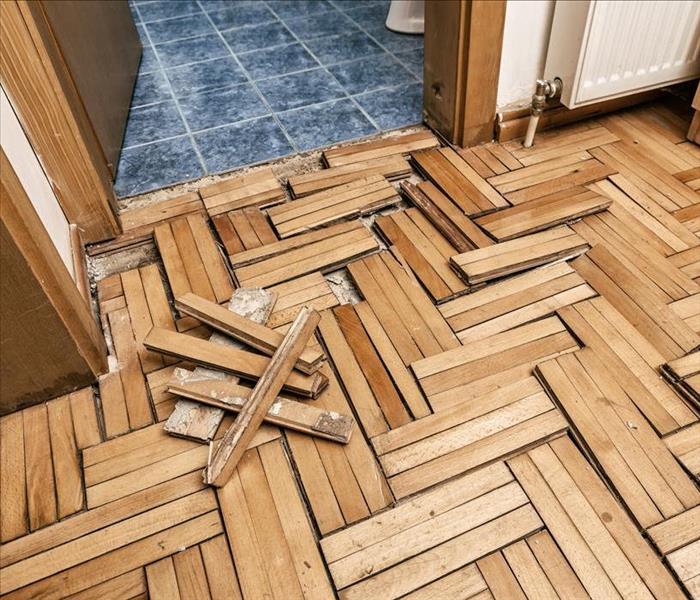 Flood Damage
Flood Damage
According to the National Weather Service (NOAA), "Approximately, five percent of all Presidential disaster declarations are associated with flooding.” NOAA lists the most common flood hazards in the United States as:
• Flash Flooding
• River Flooding
• Storm Surge and Coastal
Inundation from Tropical
and Non-Tropical Systems • Burn Scars/Debris Flows
(Caused by Wildfires)
• Ice/Debris Jams
• Snowmelt
• Dry Wash (Caused by heavy
rainfall in dry areas)
• Dam Breaks/Levee Failure
Just because you haven’t experienced a flood doesn’t mean you will not live in the future. 20% of all claims paid by the National Flood Insurance Program (NFIP) were for policies in low-risk communities. On average, floods cost $3.5 billion in annual losses in the United States.
When catastrophic water damage happens to you, SERVPRO® Franchise Professionals can help. They can help you prepare ahead of time with an Emergency Ready Profile® (ERP), or respond to any size disaster to begin cleanup and restoration to get you back in your home as soon as possible.
SERVPRO® of Blount County Professionals are ready to help make it “Like it never even happened.”
Winter Weather Worries
1/15/2019 (Permalink)
 Winter Weather Maryville
Winter Weather Maryville
Winter weather can bring about more issues than just slippery roads and a sidewalk to shovel. If you live where temperatures sink below freezing level, you are also at risk for frozen pipes and ice dams, which can create a major disaster at your home or property.
FROZEN PIPES
Frozen pipes are often those exposed to the cold weather, such as those outside your house, or in cold areas such as basements, attics, garages or kitchen cabinets.
A frozen pipe can burst at the point where the ice blockage inside the pipe is located, but typically the rupture is caused by the backflow pressure between the water source and the obstruction. A burst pipe can cause considerable damage to your property if not addressed quickly.
To prevent pipes from freezing, here are a few steps you can take, according to The American Red Cross.
-Be sure to thoroughly drain water from swimming pool and sprinkler lines, as well as outside hoses.
-Open kitchen cabinets to let warm air circulate near the plumbing.
-When the weather is frigid, let water drip from faucets that may come from exposed pipes.
-Keep your heat set to the same temperature both day and night.
ICE DAMS
Ice dams can be a little-known, but a significant problem during the snowy season. They form when heated air melts roof snow downward into water dammed behind still-frozen ice. When the trapped water cannot safely flow or run into the gutter system, it can backflow under the roof ’s shingles and into the structure’s interior areas, as well as causing gutters and shingles to move or fall.
Icicles can be an initial sign of an ice dam, according to Travelers.com. To spot ice dams inside, “check for water stains or moisture in your attic or along the ceiling of the exterior walls of your house. Water stains or moisture may be an indication that an ice dam has formed and water has penetrated the roof membrane.”
Removing an ice dam as soon as it is found is vital to help prevent damage to your property and can be done using heated cables, a roof shovel or calcium chloride ice melter.
If winter weather causes water damage to your property,SERVPRO® of Maryville and Alcoa are only a call away, 24/7, ready to
restore to preloss condition.
Keeping Wind Damage in Check
10/29/2018 (Permalink)
When the weather turns ugly in Maryville/Alcoa, TN, homes aren’t the only structures are risk. Business owners know they must take steps to protect their companies. While preventing a roof leak is a good strategy for protecting inventory and equipment, you can’t afford to ignore the risks of high winds. Here are four ways to protect your business from them.
1. Reinforce Garage-Style Doors
Garage-style doors often do not fare wear during inclement weather. These doors are usually large and flimsy. If your business has one, you should think about reinforcing it. Lumber or metal rods can increase the chances that your company’s garage doors will ride out the storm without damage. Moreover, if you are expecting heavy rains, you should ensure all doors are securely closed before evacuating ahead of a storm.
2. Clear Trees and Other Debris
Damage to roofing systems can cause a roof leak. If you can keep trees and other debris from crashing through your business’s roof, you are ahead of the game. Consider trimming overhanging branches and removing landscaping waste a few times each year.
3. Anchor Projectiles
Before severe weather hits, you should consider walking around the outside of your business. Pay special attention to possible projectiles. If you see anything that may fly freely through the air during a storm, you should anchor it. Moving hazards inside or using tie-down straps is often an effective approach.
4. Use Tarps and Plywood
Water damage can destroy the inside of your business. If you have a damaged roof or missing shingles after a wind storm, tarps and plywood can help control water damage. Use these until you have time to schedule a total roof repair.
If you have a roof leak or other storm damage, a reputable restoration service can likely help you return your business to its pre-storm condition. Still, with a bit of effort, you can keep wind damage in check.
You can be ruined or you can be read
6/25/2018 (Permalink)
Technology can now be a vital tool in preparing for emergencies or disasters, as well as during or after to stay informed of the situation and in communication with others. From common technology you already use day-to-day basis to taking a few extra steps to prepare, the following will help you be ready in the event of a disaster.
Store Information Online
There are many places to store important information securely online. Services like Google Drive and Dropbox offer a free way to store different types of files, from a Word document to images of important documents. Ready.gov suggest saving an electronic version of insurance policies, identification documents, medical records and information about your pets, if necessary.
Follow The News
Stay informed by following agencies such as FEMA, local news channels, and local government on Twitter for the most up-to-date information in a disaster situation. You can also alert first responders if rescue is needed through Twitter.
Mark Yourself Safe
The American Red Cross offers a Safe & Well check-in site to list yourself as asafe or find family and firends in situations. where communication is difficult to estabish.
Facebook also has a feature called Safety CHeck that is activated after natural disasters or crisis. You will receive a notification from Facebook if you're located in an affected area at that time.
Get In Touch
Make sure your contact information is up-to-date in your phone and email for communication with your family, friends, business contacts and others whom you may need to get in contact with before, during, or after a disaster.
Charge Up
Keep a portable charger in your car and home in case of an emergency. You may need to recharge this from time to time, but you can also buy solar-powered chargers as well.
Get an Emergency READY Profile.
SERVPRO is proud to offer Emergency READY Profiles for free and ready.SERVPRO.com to help prepare you, your property, or your business for an emergency.
By developing a SERVPRO Emergency READY Profile for your property or business, you minimize business interruption by having an immediate plan of action. Knowing what to do and what to expect in advance is the key to timely mitigation and can help minimize how water and fire damage can affect your property or business.
Put help in the palm of your hand with the Ready Plan App. Get in touch with SERVPRO of Maryville and Alcoa today for more information on developing and ERP for your property or business.
Faster To Any Disaster
5/28/2018 (Permalink)
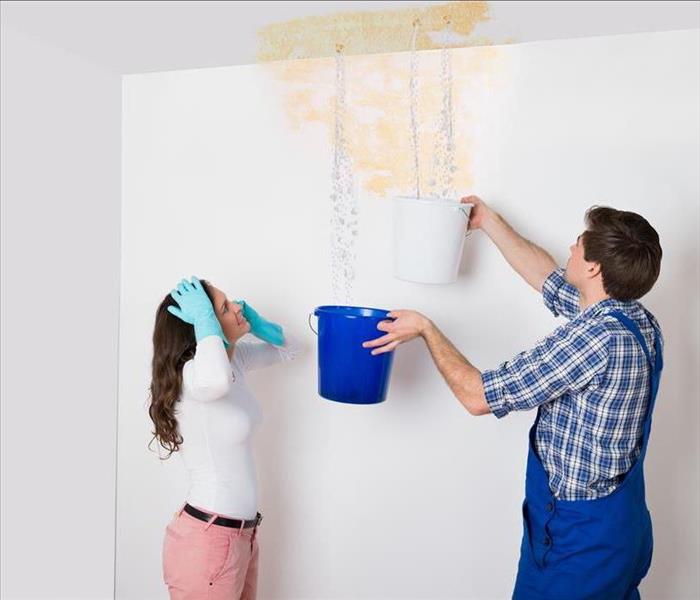 SERVPRO can fix it!
SERVPRO can fix it!
There is no disaster that hits home quite like a disaster to your property, home or business. When you have suffered a fire and water or mold damage, you don't have time to waste searching for a company to fix your property. When disaster strikes, depend on SERVPRO of Maryville and Alcoa to fix it.
Whether the job is big or small, SERVPRO of Maryville and Alcoa will be there to help make it "Like it never even happened." so you can get back to your home or business and on with your life.
SERVPRO of Maryville and Alcoa has experts who deal with mold mitigation and remediation process and what may take place if you are dealing with mold loss. As well as expertise in biohazard, crime scene, and vandalism cleanup. Whatever it maybe you can count on SERVPRO of Maryville and Alcoa .
Busted Pipe In Maryville Home
4/17/2018 (Permalink)
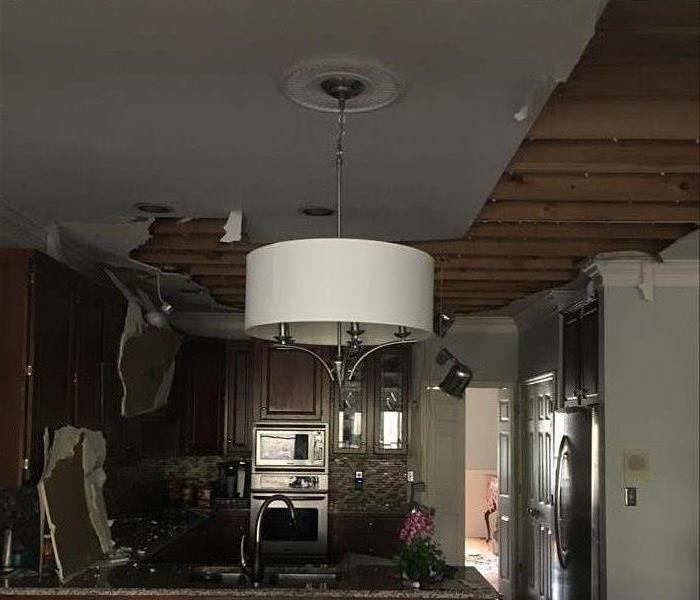 Water Damage Maryville
Water Damage Maryville
Water damage can happen at any time. Most of the time it is when you least expect it. Mr. Summner experienced this when he was away on vacation. A pipe burst in his ceiling, but it was not until two weeks later that a neighbor noticed the damage. The pipe had been leaking from an 18-foot ceiling. His first call was to SERVPRO of Maryville/Alcoa. Our highly trained professionals came out immediately to asses the damage. Since the pipe had been leaking for an extended period of time there was a lot of damage. 50% of the entire ceiling had to be torn out and replaced. All of the hardwood floors in the house had to be removed. The subfloor was either dried or removed. We were able to replace the flooring. All in all, over 5000 square feet of the house was damaged. Mr. Summner was extremely pleased with how quickly and professionally our team was.
Leave the Hassle of Board-Ups to the Professionals In Maryville, TN
9/22/2017 (Permalink)
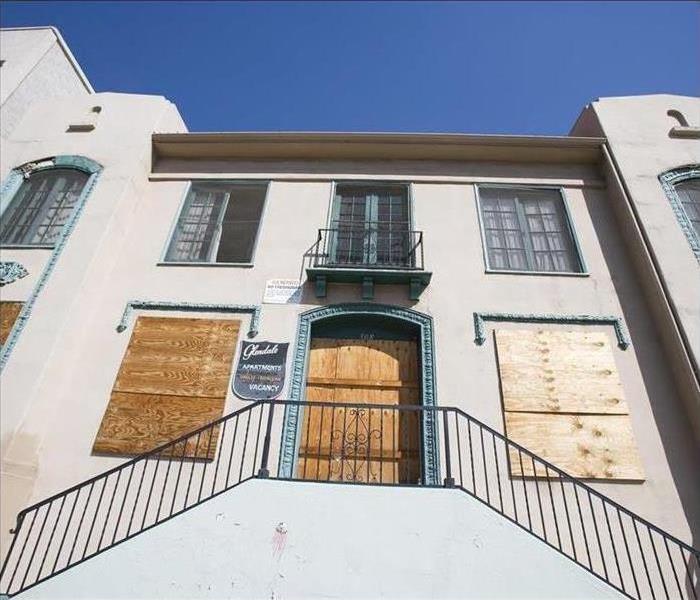 Storm Damage
Storm Damage
Whether after a fire, storm, or other structural disaster, boarding up damaged property is a burden that no one should ever have to go through- especially if it is your property that has been damaged. SERVPRO of Maryville/Alcoa has handled many storm and fire damage and knows the correct way to board and prepare your home.
Boarding up damaged property incorrectly could cause secondary damages such as moisture or animal intrusion, making the situation even worse. The process of boarding up after an unexpected damage can also be as dangerous as the damage itself.
Your SERVPRO of Maryville/Alcoa Professionals can board up the damaged property and mitigate and remediate the original damage, providing you with peace of mind while helping make it "Like it never even happened."
Storm Damage Cleanup in Alcoa, TN
9/22/2017 (Permalink)
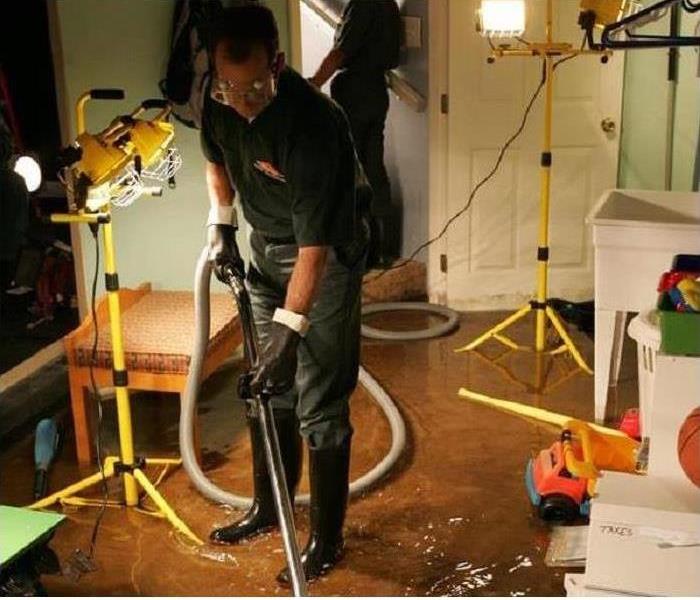 Storm Damage Cleanup
Storm Damage Cleanup
DID YOU KNOW?
SERVPRO of Maryville/Alcoa has been cleaning water damages in the local Alcoa, TN market for over 38 years. From toilet overflows, pipe bursts, dishwasher leaks, basement floods, and much more, SERVPRO of Maryville/Alcoa has been providing Alcoa with quality cleanup and restoration work 24 hours a day, 365 days a year. That's over 332,880 hours of being on call to help our clientele!
SERVPRO understands that even the smallest of water problems can be a major catastrophe for the average homeowner. Whether it be damaged property, mold growth, health concerns or other problems, SERVPRO has all the right tools to make it "Like It Never Even Happened®."
With over 190 years of combined experience with our technicians, SERVPRO will promptly arrive at your business or residence, assess the damage, provide a solution, and begin work to ensure that secondary damages do not occur. From extracting water, dehumidification, decontamination, mold remediation, full repairs and construction, SERVPRO is here to help day or night.
With free estimates and consultations in Alcoa, insurance billing availability, we're standing by to be of assistance to anyone in need. Find out more about all of our services here.
Be Storm Smart
9/22/2017 (Permalink)
Be Storm Smart
Severe weather can happen anytime, anywhere. Each year, Americans cope with an average of these following intense storms.
10,000 severe thunderstorms
5,000 floods or flash floods
1,000 tornadoes
2 land falling deadly hurricanes
Approximately 98 percent of all presidentially declared disasters are weather-related, leading to around 500 deaths per year and nearly $15 billion in damage. Knowing your risk of severe weather, taking action and being an example are just a few steps you can take to be better prepared to save your life and assist in saving the lives others.
Know Your Risk. The first step to becoming weather-ready is to understand the type of hazardous weather that can affect where you live and work, and how the weather could impact you, your business and your family. Check the weather forecast regularly, obtain a NOAA Weather Radio, and learn about Wireless Emergency Alerts. Severe weather comes in many forms and your shelter plan should include all types of local hazards.
Take Action. Take the next step in severe weather preparedness by creating a communications plan for your home and business. Put together or purchase an emergency kit. Keep important papers and valuables in a safe place.
Be an Example. Once you have taken action to prepare for severe weather, share your story with co-works and family and friends on Facebook or Twitter. Your preparedness story will inspire others to do the same.
Build An Emergency Supply Kit
Water (one gallon per person per day)
Food (non-perishable 3-day supply)
Manual can opener
Battery operated radio, preferably a NOAA Weather Radio
Flashlight and extra batteries
First aid kit
Whistle to signal for help
Clothing
Dust masks or bandanas
Plastic sheeting, garbage bags, and duct tape
Wrench or pliers to turn off utilities
Hygiene items
Important documents; copies of insurance policies, identification, and bank account information
Cash
Fire extinguisher
Matches in a waterproof contain
Frozen Pipes In Alcoa, TN
6/22/2017 (Permalink)
 Frozen Pipes
Frozen Pipes
Frozen pipes are a leading cause of water damage in the colder months of the year. Why?
Water has the unfortunate property in that as it freezes, it expands. This can affect all types of water lines, whether metal, plastic, or PVC. Simply, all pipes are subject to bursting given the right amount of pressure. As the water freezes, it can expand the pipe, eventually, cause a hairline crack or a complete break. At that point the portion unfrozen will then provide a continual stream of water until shut off, causing water damage throughout the property.
How can I prevent my pipes from freezing or bursting?
If possible, make sure that all pipes and supply lines on exterior walls are insulated. Exterior walls will be much colder than interior walls given their location. Additionally, all water lines in basements and crawl spaces need to be insulated as they will be subjected to very cold temperatures. Simple foam insulation wrap can help prevent your pipes from freezing.
Make sure all outdoor hoses are removed from exterior hose bibs.
Always keep your heating unit on and operational, even when away on vacation. If leaving for an extended period of time, set your thermostat to no colder than 55 degrees to ensure that your home has enough heat to properly keep interior pipes from freezing.
Keep garage doors closed if you have water supply lines located in that area. In extreme cases of cold for extended periods of time, ensure that exposed pipes are insulated. Space heaters (placed away from anything flammable) can provide heat and warmth to combat cold environments in garage areas.
If you notice very low water pressure from water supply areas, a frozen pipe could be the cause. Immediate action should be taken to identify the problem.
What should I do if my pipes are already frozen?
Turn on all the faucets with warm water, not hot, to a slow drip. This will help in supplying warmer water to the area without causing an abrupt temperature change. It will also help you in determining the location of the freeze.
Apply exterior heat to the frozen section of pipe. This can be done with a hair dryer, electric heating pad, space heater, towels soaked in warm water wrapped around the pipe. NEVER use open flame devices as this can be a major fire hazard.
Keep the continual heat on the area until water flow is restored to normal.
Once restored, try to determine why the area froze. It may be as simple as adding insulation, sleeve wraps, UL listed heat tape, or another form of insulation.
If you cannot locate, find, or properly thaw your pipes, call a professional plumber to assist.
What if my pipes burst and caused damage?
If your pipes have busted, cracked, or began leaking, immediate action should be taken to ensure that water damage can be minimalized to your property. Soak up as much water as possible with towels or extract with a shop vac. It's often necessary to have professionals like SERVPRO come in and completely mitigate the water. Home drying efforts can help reduce damages, but will not get rid of all moisture and humidity. It's important to ensure that your property is completely dry and dehumidified to prevent secondary damage from ruining your home, flooring, furnishings, or building materials. Call SERVPRO today if you've had water damage from a pipe leak, and we'll work with you and/or your insurance company to make sure that your home is restored correctly!
Exploring the Science of Drying in Maryville
6/22/2017 (Permalink)
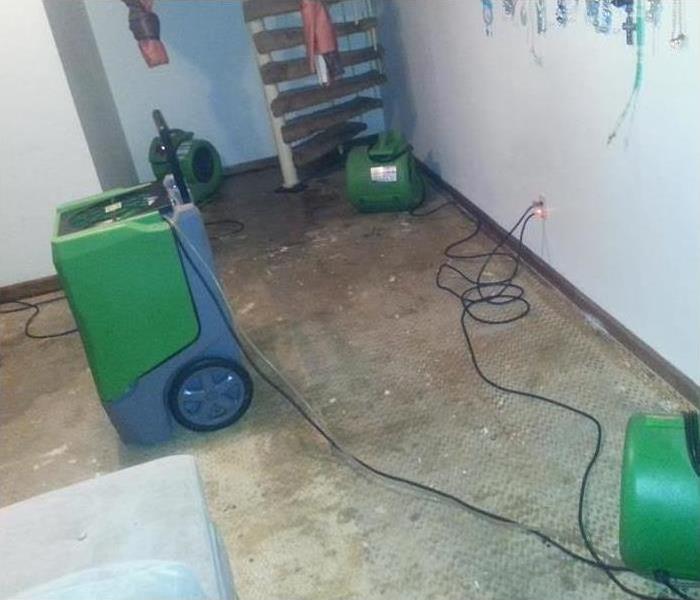 Drying Water Damage in Maryville, TN
Drying Water Damage in Maryville, TN
Exploring the Science of Drying
Did you know, there is actually a science behind the process of drying? The knowledge of psychometrics is essential to restoring a water damaged structure to its preloss condition. While your initial reaction may be to grab a few towels to mop up the mess and places a fan or two around the damage is.
What exactly does “speed up Mother Nature” mean? A wet building can often dry naturally because the environment always seeks equilibrium. When materials are wet, moisture will naturally move to drier air on the surface of the material but only if the air is, indeed dryer. The only problem is, nature takes too long and secondary damages may occur while the building is drying out.
SERVPRO of Blount County has been trained to use top-of-the-line equipment to help Mother Nature along, including equipment to help dry hardwood floors, tough-to-reach spaces inside walls, and much more. SERVPRO of Blount County also use state-of-the-art monitoring equipment and a proven scientific process to help speed the drying of your home or business.
SERVPRO of Blount County is proud to utilize a newly developed tool SERVPRO DryBook.
The SERVPRO DryBook is a proprietary tool allowing us to capture and track the steps of restoration project according to industry best practices and standards. This ensures your restoration is done properly and efficiently. It also improves results and restores your property at a faster rate, getting you backing your home sooner.






 24/7 Emergency Service
24/7 Emergency Service
